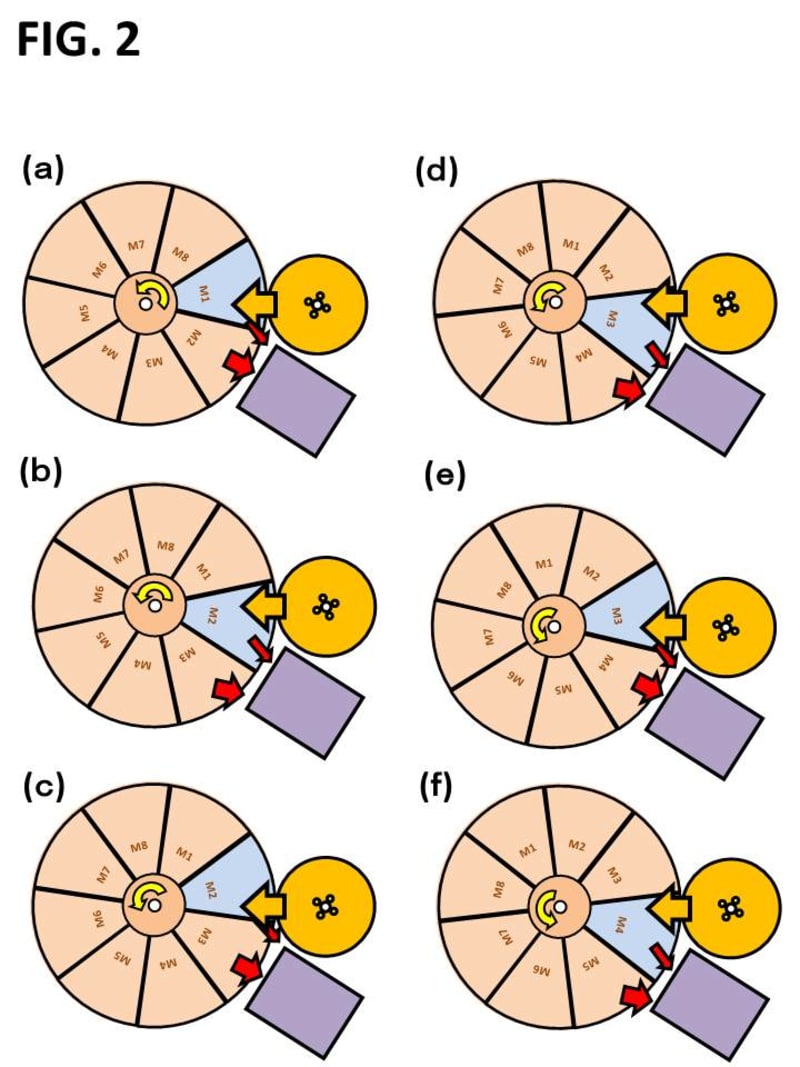Now, I will explain about a Perpetual Motion Machine using an Inverse Magnetostrictive Effect. I hope this Machine is to contribute to solving the world‘s energy problems. Also, please see the attached YouTube video. This YouTube video will help you to understanding the invention.
This Machine generates a rotational energy by using the Inverse magnetostrictive effect. The Inverse magnetostrictive effect is also known as the Villari effect. First, I will explain about the Inverse magnetostrictive effect. As the magnetostrictive material, there is an iron-gallium alloy. As with iron, the magnetostrictive material has the property that is attracted to the magnet as shown in Figure 3(a). As shown in Figure 3(b), if a pressure is applied to the magnetostrictive material, the property that is attracted to the magnet is weakened.
Next, I will explain about the Perpetual Motion Machine. Make a Wheel from the magnetostrictive materials M1-M8 as shown in Figure 1(a). Place a magnet next to the wheel. The Magnetostrictive materials are attracted to the magnet.
As shown in Figure 1(b), the pressure is applied to the magnetostrictive materials by a Roller. When the pressure is applied to the magnetostrictive material M1, the property that is attracted to the magnet of the material M1 is weakened. Another magnetostrictive material M2 is strongly attracted to the magnet. For that reason, the wheel rotates.
Wheel rotation swaps the position of the magnetostrictive materials M1 and M2 as shown in Figure 2(a)-(b). Accordingly, the pressure is applied to the magnetostrictive material M2. The property that is attracted to the magnet of the material M2 is weakened. Another magnetostrictive material M3 is strongly attracted to the magnet. The wheel rotates continuously as shown in Figure 2(c)-(f). Repeat the same motion, the wheel will continue to rotate.
This machine uses the wheel. The wheel is a great invention on the history of mankind. We can carry heavy objects with a small force. This is because the rolling resistance of the wheel is very small. For example, a force required to rotate a wheel of a railway train is just 0.2kgf-1.0kgf per train weight 1000kg. If the rotative force is greater than the rolling resistance, the Wheel will rotate.
When the pressure is applied to the magnetostrictive material, the inside magnetic flux density varies greatly. For example, the inside magnetic flux density will change about 1 Tesla. 1 Tesla is 10,000 Gauss. The force to rotate the wheels can be generated by the magnetostrictive material.
When the pressure is applied to the magnetostrictive material, the property that is attracted to the magnet varies greatly. Compressibility of the magnetostrictive material is very small, so it hardly deformed. Therefore, the rolling resistance of the wheel is very small. While a center of gravity of the wheel is kept substantively a center of the wheel, bias occurs in the intensity distribution of the magnetization in the wheel. Without entering the energy from outside, the wheel continues to rotate.
Video
Like this entry?
-
About the Entrant
- Name:Tomooki Seki
- Type of entry:individual
- Software used for this entry:PowerPoint
- Patent status:pending








